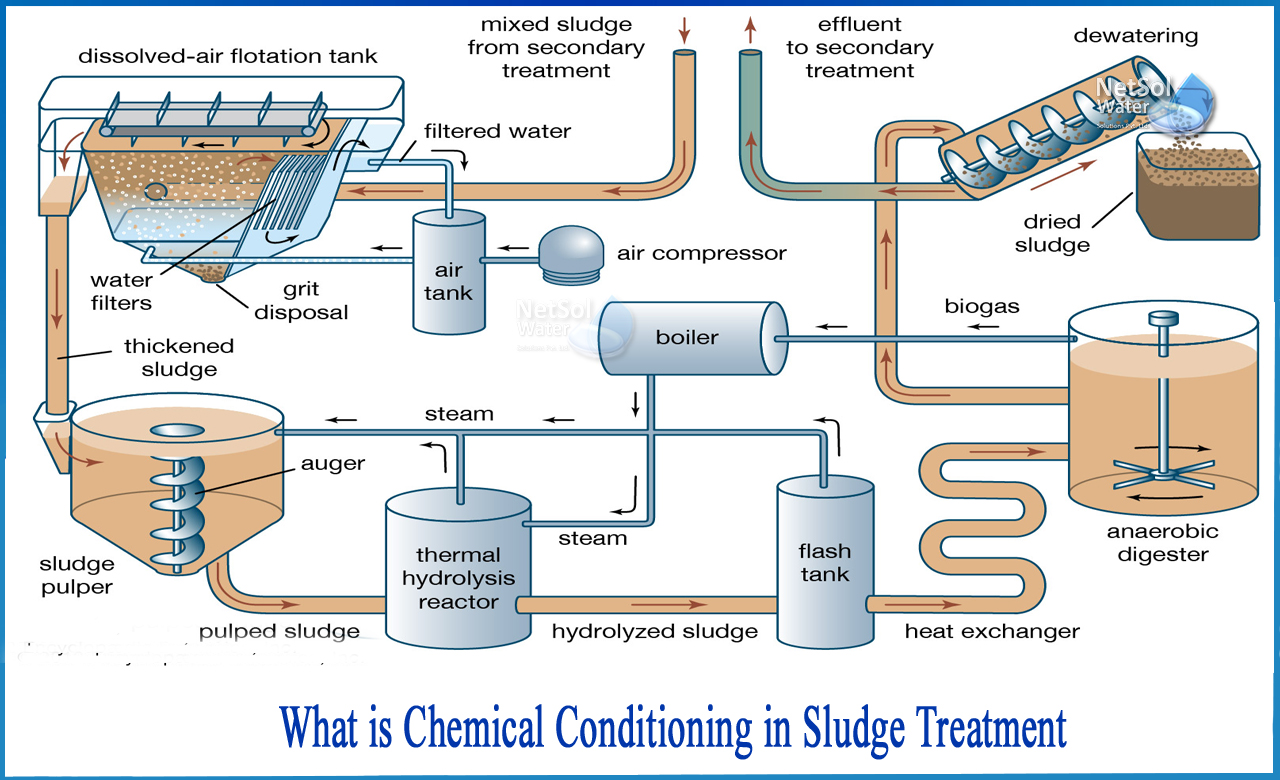What is chemical conditioning in sludge treatment?
Chemical conditioning is the chemical pre-treatment of sludge prior to the concentration and dehydration process.
Sludge Conditioning Chemicals and Their Effects
Sludge conditioning is done to help remove water from solids and is most often achieved by administering chemicals. Conditioning fuses (or aggregates) small sludge particles (1-10 µm) to produce large sludge particles, reducing colloidal sludge content (particle size/polymer size <0.1 µm). This improves both particle settling and product cake permeability, increasing the efficiency of downstream thickening and dehydration processes.
Chemical conditioning is achieved by administering the following to the sludge:
>Inorganic (or mineral) coagulant (such as iron or aluminium) and/or
>Organic flocculent (or polymer). Mineral reagents are suitable for processes such as mechanical dehydration (belts, filter presses, etc.). In this process, strong flakes take precedence over large compressible flakes. Mineral coagulants include:
-Iron chloride or aluminium chloride or sulphate (FeCl3, Fe2 (SO4) 3, AlCl3, Al2 (SO4) 3)
-Iron (III) Chloro-sulphate (FeClSO4)
-Poly-aluminium or poly-iron salt
-Lime used for alkali stabilization (slaked lime, Ca. (OH) 2) or quicklime, CaO).
-Iron (III) salts, especially iron (III) chloride, are preferred for both economic and effectiveness reasons.
How does flocculants and coagulants work?
The flocculants work by reducing the surface charge of the repulsive sludge particles and aggregating the particles by this destabilizing effect. Coagulant doses can be supplemented with lime doses to increase the filtration capacity of the cake and retain the more toxic metal in the solids. The addition of lime stabilizes sludge and reduces its putrefaction, odour, and content of pathogenic microorganisms.
What is the use of polymers?
Polymers, usually high molecular weight polyelectrolytes, can be used alone or as a supplement to the dosage of inorganic coagulants for some dehydration techniques such as filter presses.
If the polyelectrolyte is cationic in nature, the polymer works by forming bridges between sludge particles with an additional particle destabilizing effect (like the effect of inorganic coagulants).
There are many different polymer products with different charge polarities (cationic, anionic, neutral), charge density (charge per unit volume), structure (branched or linear, etc.), and molecular weight.
What are these used for?
Cationic poly-acrylamides are used for sludge’s high in organic matter (OM/suspended solids> 40%) and/or cellulose fibres. These chemicals come in a variety of molecular weights. Medium molecular weight polymers are suitable for pressure belt filtration, which requires high drainage, while very high molecular weight polymers are mechanically strong and tend to produce shear resistant flakes suitable for centrifugation.
Anionic polyelectrolytes are suitable for the treatment of high inorganic content suspensions or slurries, for example from metal hydroxide precipitates. Therefore, these polymers tend to be used in combination with mineral coagulants.
Sludge Conditioning Chemical Dosage
The dose of coagulant or polymer required to adjust the sludge depends on both the sludge properties and the downstream dehydration technique. Clinical tests are always required to determine the chemical type and dosage of the polymer.
A high content of sludge fibre or high-density granular solids tends to reduce the dose of coagulant chemicals required, but a high protein content increases it. The addition of inorganic reagents increases the concentration of inert solids in the sludge.
Approximately 60-70% of the added FeCl3 and 80-90% of the administered lime enter the dehydrated solid (or cake fraction). Organic polymers, on the other hand, can be thermally destroyed along with other organic components and do not adversely affect the calorific value of sludge during downstream anaerobic digestion or thermochemical treatment processes.
Chemical administration method for sludge conditioning
Inorganic chemical treatment of sludge may include agglutination in continuous mixing tanks. The first is a metal salt (usually alum or ferric chloride) and the second is lime.
Use a high stirring rate (150-300 W / m3) for a short time (5-10 minutes) and then use for a long time under slow mixing conditions to grow aggregated particles (or flakes).The flakes formed by conditioning should be obtained with low shear when carrying sludge, for example using a screw pump or an eccentric screw pump. Long-term storage of conditioned sludge can also adversely affect its filterability, as the natural biodegradation of organic matter can produce colloidal substances.
Conclusion
Conditioning chemicals can be delivered in solid or liquid form, and liquid polymers are delivered as emulsions. When supplied as a powder, the polymer should be stored in a dry place, quickly premixed with water to form a ready-to-use 2-5 g /L solution, and then allowed to stand (20-30).
The solution should be prepared regularly as the effectiveness of the dissolved polymer slowly declines in a few days. Infusion of the polymer can be done by simple in-line mixing, as in the case of thickening of centrifugal or gravity drums, the rotational effect in the process provides sufficient effective mixing to promote aggregation. Other concentration/dehydration techniques usually require a special premix upstream for 20-60 seconds.
Netsol Water is Greater Noida-based leading water & wastewater treatment plant manufacturer. We are industry's most demanding company based on client review and work quality. We are known as best commercial RO plant manufacturers, industrial RO plant manufacturer, sewage treatment plant manufacturer, Water Softener Plant Manufacturers and effluent treatment plant manufacturers. Apart from this 24x7 customer support is our USP. Call on +91-9650608473, or write us at enquiry@netsolwater.com for any support, inquiry or product-purchase related query.



